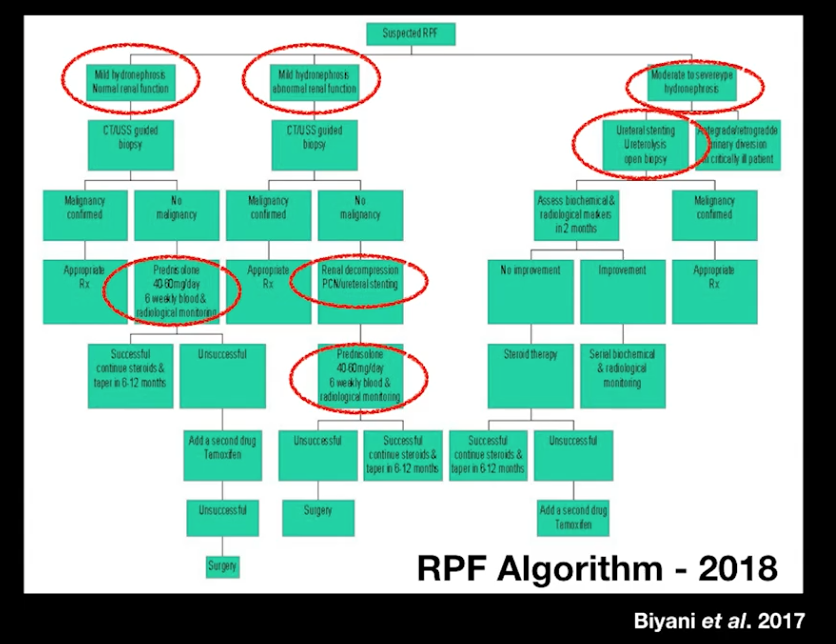Samit D. Soni, MD, presented “The Medical and Surgical Management of Retroperitoneal Fibrosis in the Minimally Invasive Era” during the 23rd Annual Innovations in Urologic Practice on September 14, 2018 in Santa Fe, New Mexico.
How to cite: Soni, Samit D. “The Medical and Surgical Management of Retroperitoneal Fibrosis in the Minimally Invasive Era” September 14, 2018. Accessed Nov 2025. https://grandroundsinurology.com/the-medical-and-surgical-management-of-retroperitoneal-fibrosis-in-the-minimally-invasive-era/
The Medical and Surgical Management of Retroperitoneal Fibrosis in the Minimally Invasive Era – Summary:
Samit D. Soni, MD, reviews the contemporary algorithm for the management of retroperitoneal fibrosis (RPF) in 2018. He discusses imaging, specific medical and surgical approaches, as well as operative advice for minimally-invasive surgery for RPF.
Abstract:
Retroperitoneal fibrosis typically affects an area centered over the anterior surface of the 4th-5th lumbar vertebrae, leading to entrapment and obstruction of retroperitoneal structures. Most RPF cases are due to idiopathic causes. However, it is important to note that malignancy, infection, or prior therapy-related causes can account for some cases. Imaging is essential for diagnosing RPF, as well as tissue biopsy to exclude malignancies and differential diagnoses.
This presentation illustrates typical imaging findings of RPF on CT scan, MRI, and retrograde pyelography. It also examines a treatment algorithm updated in 2018, which notably utilizes degree of hydronephrosis to drive the decision to proceed with either surgical or medical intervention.
A medical approach is appropriate for patients with mild hydronephrosis, though this presents certain challenges. Currently, the established medical protocols for RPF include corticosteroids, tamoxifen, and azathioprine. Unfortunately, none of these ‘cure’ idiopathic RPF, and they all carry significant side effects with lifelong impacts. Moreover, only limited evidence regarding these therapies is available, and there is no consensus as to the definition of treatment response or failure.
Surgical management should be a second-line approach for those who have failed medical therapy or first-line for those with moderate to severe hydronephrosis. The aim of surgery should always be to resolve the obstruction and to exclude underlying malignancies instead of treating the RPF. Certain temporizing maneuvers can be appropriate for high-risk or elderly patients. However, utilizing these techniques in the long-term leads to morbidity risks related to repeated general anesthesia. Although effective, open definitive surgical management for RPF carries a significant morbidity burden.
Minimally-invasive surgery can mitigate this morbidity with equal effectiveness. However, there is limited data comparing open and robotic procedures. This presentation concludes with a demonstration of various tips and tricks for the minimally-invasive surgical management of RPF.
About Innovations in Urologic Practice
Innovations in Urologic Practice (IUP) is an annual CME-accredited conference devoted to updating urologists on the rapidly changing healthcare environment. Topics focus on innovative diagnostic and treatment strategies, controversies, new and currently developing technologies, and challenges in today’s urologic practice. Dr. Soni presented this lecture during the 23rd IUP in 2018. Please visit this page in order to learn more about future IUP meetings.
ABOUT THE AUTHOR
Dr. Samit D. Soni is a urologist with Memorial Hermann Medical Group in Houston, Texas. He received his MD from Baylor College of Medicine and went on to complete his internship, residency, and fellowship at Baylor as well. Dr. Soni specializes in advanced robotic and laparoscopic urologic surgery, and in endourology. He has performed more than 1,000 robotic and laparoscopic surgeries to treat a diverse set of conditions, including locally advanced kidney cancer, metastatic testicular cancer, endometriosis, fistula, and ureteral injury. Dr. Soni also specializes in advanced percutaneous and endoscopic procedures for the management of complex kidney stones. He frequently performs single-site laparoscopic donor nephrectomies as well. His clinical activities led to his selection as a “Top Urologist in Houston” for 2016 and 2017. In addition, Dr. Soni is an active researcher. His research interests include the development of new drug delivery platforms and medical devices, and the application of new technology for surgical advancement. Projects he has been involved with include a “Robotic Bilateral Salvage Retroperitoneal Lymph Node Dissection with Single-Dock Approach,” a “Step-by-Step Approach to Robotic Intracorporeal Continent Ileocecal Augmentation Cystoplasty,” and a look at “Molecularly Imprinted Polymers for Recognition of Cholesterol.” He is also a reviewer for the Journal of Urology.


